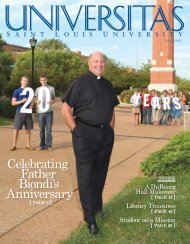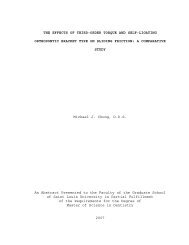ACL RECONSTRUCTION WITH PATELLAR TENDON AUTOGRAFT ...
ACL RECONSTRUCTION WITH PATELLAR TENDON AUTOGRAFT ...
ACL RECONSTRUCTION WITH PATELLAR TENDON AUTOGRAFT ...
You also want an ePaper? Increase the reach of your titles
YUMPU automatically turns print PDFs into web optimized ePapers that Google loves.
Scott Kaar, MD and Adnan Cutuk, MD<br />
Department of Orthopaedic Surgery<br />
Sports Medicine and Shoulder Service<br />
Biceps Tenotomy / Tenodesis / Subacromial Decompression /<br />
Partial Thickness Rotator Cuff Tear Debridement / Distal Clavicle<br />
Excision Rehab Protocol Prescription<br />
Patient Name: Date:<br />
Diagnosis: Rotator cuff tear long head biceps tearing AC joint arthrosis<br />
Frequency: 2-3 visits/week Duration: 4 months<br />
Post-operative Period<br />
0 to 1 month:<br />
1. 2 to 3 visits per week, everyday home program with goals<br />
2. Sling is to be worn at all times for 3 weeks, including for sleep, except when doing<br />
exercises.<br />
3. Motion of the elbow should be limited to passive motion only<br />
4. No active shoulder motion<br />
5. Modalities as needed<br />
6. Active and passive range of motion of the neck, wrist and hand should be performed<br />
3 to 5 times/day everyday<br />
7. Wrist 6-way exercises<br />
8. Gentle passive pendulum/Codman’s exercises should be started immediately and<br />
performed 3 times a day<br />
9. Gentle passive elevation in the scapular plane to full/internal rotation at the side<br />
10. Cryotherapy, 3 to 5 times a day, 20 minutes each after exercises<br />
1 to 2 months:<br />
1. 2 to 3 visits per week, 5 times a week home program with goals<br />
2. Continue all exercises in previous phase (as described above)<br />
3. Passive, active assisted, and active range of motion (including elbow motion) can<br />
begin with a gradual return to full motion<br />
4. No biceps strengthening exercises in this phase
5. Active scapular retractions, protractions, depression, elevation<br />
6. Begin isometric shoulder strengthening exercises including abduction, forward<br />
flexion, extension, internal and external rotation<br />
7. Advance periscapular strengthening and range of motion exercises should begin with<br />
light weights and bands exercises<br />
8. The emphasis should be directed towards regaining full shoulder motion and<br />
restoring scapulohumeral kinematics<br />
2 to 3 months:<br />
1. 2 to 3 visits per week, with a home program with goals 5 times a week.<br />
2. Continue exercises in previous phases (as described above)<br />
3. A strong emphasis on periscapular strengthening and range of motion exercises<br />
should continue with scapular protraction, retraction, and elevation<br />
4. Rotator cuff strengthening exercises (with bands and dumbbells) may begin once<br />
active range of motion is full<br />
5. Gentle biceps strengthening exercises should begin with very light weights and high<br />
repetitions<br />
6. Range of motion should be full by 3 months.<br />
3 to 5 months:<br />
1. 4 to 5 times a week home program. 1 to 2 visits per week to advance home program<br />
with goals.<br />
2. Continue exercises in previous phases (as described above)<br />
3. Range of motion must be full in order to begin this phase of rehabilitation.<br />
4. Active shoulder and periscapular muscle strengthening exercises are the focus of this<br />
period with the emphasis to regain full strength. Strengthening exercises should be<br />
high repetition, low weights with dumbbells and bands<br />
5. Biceps strengthening exercises can be advanced, however, light weights and high<br />
repetitions should be emphasized<br />
5 to 8 months:<br />
1. 3 to 5 times a week home program with goals. May need physical therapy<br />
supervision for functional training.<br />
2. Begin advanced strengthening with weights, dumbbells and bands to include muscles<br />
of the shoulder girdle, rotator cuff, and periscapular areas. Low repetition and high<br />
weights should be avoided indefinitely<br />
3. May begin functional training exercises including swimming, tennis, or an interval<br />
throwing program (if a thrower)<br />
4. Begin gradual return to previous sports/activities/work duties under controlled<br />
conditions<br />
5. Full return to sports/activities/full work duties are pending Dr. Kaar’s or Dr. Cutuk’s<br />
approval based upon the following criteria:<br />
Criteria for Return to Sports/Full Activities:<br />
1. Full functional range of motion<br />
2. No pain or tenderness<br />
3. Satisfactory muscular strength (Isokinetic Test)
4. Satisfactory clinical examination<br />
Problems or Questions: Please contact us via phone or email<br />
Dr. Cutuk’s patients please call or email :<br />
Melody (clinical nurse specialist) at (314) 577-8524 / email: temarem@slu.edu<br />
Dr. Kaar’s patients please call or email:<br />
Duncan (clinical nurse specialist) at (314) 577-8525 / email: dmchardy@slu.edu<br />
General office at (314) 256-3850 (ABI Clinic) or (314) 768-1050 (St Mary’s Clinic)<br />
Cardinal Glennon (314) 577-5646<br />
Physician Signature:
















